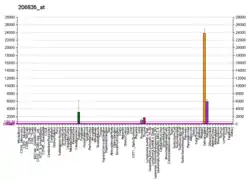STATH
Statherin is a protein in humans that is encoded by the STATH gene.[3][4] It prevents the precipitation of calcium phosphate in saliva, maintaining a high calcium level in saliva available for remineralisation of tooth enamel and high phosphate levels for buffering.[5]
| STATH | |||||||||||||||||||||||||
|---|---|---|---|---|---|---|---|---|---|---|---|---|---|---|---|---|---|---|---|---|---|---|---|---|---|
| Identifiers | |||||||||||||||||||||||||
| Aliases | STATH, STR, statherin | ||||||||||||||||||||||||
| External IDs | OMIM: 184470 HomoloGene: 88673 GeneCards: STATH | ||||||||||||||||||||||||
| |||||||||||||||||||||||||
| |||||||||||||||||||||||||
| |||||||||||||||||||||||||
| Orthologs | |||||||||||||||||||||||||
| Species | Human | Mouse | |||||||||||||||||||||||
| Entrez |
| ||||||||||||||||||||||||
| Ensembl |
| ||||||||||||||||||||||||
| UniProt |
| ||||||||||||||||||||||||
| RefSeq (mRNA) |
| ||||||||||||||||||||||||
| RefSeq (protein) |
| ||||||||||||||||||||||||
| Location (UCSC) | Chr 4: 70 – 70 Mb | n/a | |||||||||||||||||||||||
| PubMed search | [2] | n/a | |||||||||||||||||||||||
| Wikidata | |||||||||||||||||||||||||
| |||||||||||||||||||||||||
References
- ENSG00000126549 GRCh38: Ensembl release 89: ENSG00000282891, ENSG00000126549 - Ensembl, May 2017
- "Human PubMed Reference:". National Center for Biotechnology Information, U.S. National Library of Medicine.
- Sabatini LM, Carlock LR, Johnson GW, Azen EA (Jan 1988). "cDNA cloning and chromosomal localization (4q11-13) of a gene for statherin, a regulator of calcium in saliva". Am J Hum Genet. 41 (6): 1048–60. PMC 1684366. PMID 3502720.
- "Entrez Gene: STATH statherin".
- Hay DI, Smith DJ, Schluckebier SK, Moreno EC (1984). "Relationship between concentration of human salivary statherin and inhibition of calcium phosphate precipitation in stimulated human parotid saliva". J. Dent. Res. 63 (6): 857–63. doi:10.1177/00220345840630060901. PMID 6429216. S2CID 72916849.
Further reading
- Schlesinger DH, Hay DI (1977). "Complete covalent structure of statherin, a tyrosine-rich acidic peptide which inhibits calcium phosphate precipitation from human parotid saliva". J. Biol. Chem. 252 (5): 1689–95. PMID 838735.
- Raj PA, Johnsson M, Levine MJ, Nancollas GH (1992). "Salivary statherin. Dependence on sequence, charge, hydrogen bonding potency, and helical conformation for adsorption to hydroxyapatite and inhibition of mineralization". J. Biol. Chem. 267 (9): 5968–76. PMID 1313424.
- Douglas WH, Reeh ES, Ramasubbu N, Raj PA, Bhandary KK, Levine MJ (1991). "Statherin: a major boundary lubricant of human saliva". Biochem. Biophys. Res. Commun. 180 (1): 91–7. doi:10.1016/S0006-291X(05)81259-8. PMID 1718282.
- Johnsson M, Richardson CF, Bergey EJ, Levine MJ, Nancollas GH (1992). "The effects of human salivary cystatins and statherin on hydroxyapatite crystallization". Arch. Oral Biol. 36 (9): 631–6. doi:10.1016/0003-9969(91)90014-L. PMID 1741693.
- Ramasubbu N, Reddy MS, Bergey EJ, Haraszthy GG, Soni SD, Levine MJ (1992). "Large-scale purification and characterization of the major phosphoproteins and mucins of human submandibular-sublingual saliva". Biochem. J. 280 ( Pt 2) (Pt 2): 341–52. doi:10.1042/bj2800341. PMC 1130552. PMID 1747107.
- Sabatini LM, He YZ, Azen EA (1990). "Structure and sequence determination of the gene encoding human salivary statherin". Gene. 89 (2): 245–51. doi:10.1016/0378-1119(90)90012-G. PMID 2373369.
- Sabatini LM, Warner TF, Saitoh E, Azen EA (1990). "Tissue distribution of RNAs for cystatins, histatins, statherin, and proline-rich salivary proteins in humans and macaques". J. Dent. Res. 68 (7): 1138–45. doi:10.1177/00220345890680070101. PMID 2483725. S2CID 36679891.
- Dickinson DP, Ridall AL, Levine MJ (1988). "Human submandibular gland statherin and basic histidine-rich peptide are encoded by highly abundant mRNA's derived from a common ancestral sequence". Biochem. Biophys. Res. Commun. 149 (2): 784–90. doi:10.1016/0006-291X(87)90436-0. PMID 3426601.
- Oppenheim FG, Hay DI, Smith DJ, Offner GD, Troxler RF (1987). "Molecular basis of salivary proline-rich protein and peptide synthesis: cell-free translations and processing of human and macaque statherin mRNAs and partial amino acid sequence of their signal peptides". J. Dent. Res. 66 (2): 462–6. doi:10.1177/00220345870660021301. PMID 3476566. S2CID 22104713.
- Perinpanayagam HE, Van Wuyckhuyse BC, Ji ZS, Tabak LA (1995). "Characterization of low-molecular-weight peptides in human parotid saliva". J. Dent. Res. 74 (1): 345–50. doi:10.1177/00220345950740011001. PMID 7876428. S2CID 19598742.
- Gururaja TL, Levine MJ (1997). "Solid-phase synthesis and characterization of human salivary statherin: a tyrosine-rich phosphoprotein inhibitor of calcium phosphate precipitation". Pept. Res. 9 (6): 283–9. PMID 9048421.
- Iontcheva I, Oppenheim FG, Troxler RF (1997). "Human salivary mucin MG1 selectively forms heterotypic complexes with amylase, proline-rich proteins, statherin, and histatins". J. Dent. Res. 76 (3): 734–43. doi:10.1177/00220345970760030501. PMID 9109822. S2CID 39525421.
- Iontcheva I, Oppenheim FG, Offner GD, Troxler RF (2000). "Molecular mapping of statherin- and histatin-binding domains in human salivary mucin MG1 (MUC5B) by the yeast two-hybrid system". J. Dent. Res. 79 (2): 732–9. doi:10.1177/00220345000790020601. PMID 10728974. S2CID 27558675.
- Gilbert M, Shaw WJ, Long JR, Nelson K, Drobny GP, Giachelli CM, Stayton PS (2000). "Chimeric peptides of statherin and osteopontin that bind hydroxyapatite and mediate cell adhesion". J. Biol. Chem. 275 (21): 16213–8. doi:10.1074/jbc.M001773200. PMID 10748043.
- Yao Y, Lamkin MS, Oppenheim FG (2000). "Pellicle precursor protein crosslinking characterization of an adduct between acidic proline-rich protein (PRP-1) and statherin generated by transglutaminase". J. Dent. Res. 79 (4): 930–8. doi:10.1177/00220345000790040801. PMID 10831095. S2CID 37029459.
- Tamaki N, Tada T, Morita M, Watanabe T (2003). "Comparison of inhibitory activity on calcium phosphate precipitation by acidic proline-rich proteins, statherin, and histatin-1". Calcif. Tissue Int. 71 (1): 59–62. doi:10.1007/s00223-001-1084-0. PMID 12060866. S2CID 38221230.
- Yao Y, Berg EA, Costello CE, Troxler RF, Oppenheim FG (2003). "Identification of protein components in human acquired enamel pellicle and whole saliva using novel proteomics approaches". J. Biol. Chem. 278 (7): 5300–8. doi:10.1074/jbc.M206333200. PMID 12444093.
This article is issued from Wikipedia. The text is licensed under Creative Commons - Attribution - Sharealike. Additional terms may apply for the media files.


